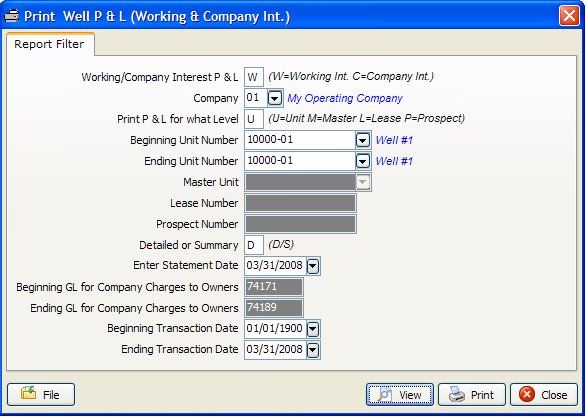Financials ››
Select Financials - Wells - P&L (Working Interest and Company Interest)

Derek reads through the DOI file to obtain a total working interest percentage for each status of each unit. This percentage is then multiplied by the gross amount of each transaction to obtain the working interest value. (Remember: Owners in the DOI file have 8 possible status percentages available for each transaction and each owner is coded working, royalty or override). The general ledger number is reflected on the Unit P & L for Working Interest for better cross-referencing. If a unit is marked “CLOSED” in the Unit/Well file, Derek will not print a P & L for that unit.
NOTES ON FILTER FOR WELL P & L
WORKING/COMPANY INTEREST P & L: You can print the P & L for either Company Interest or Working Interest percentages.
COMPANY NUMBER: You can select which company you want to print the Unit P & L for.
PRINT P & L FOR WHICH LEVEL: Enter U=unit, M=master unit, L=lease and P=prospect. Default value is U=unit. Enter other than U=unit to print consolidated P & L's to the next highest level.
UNIT NUMBER: This is normally the individual well number and is the lowest level for tracking expenses or income. Only the unit has a chart of accounts. In case of printer mess up when printing all units, you can enter a beginning unit number and ending unit number. There are no general ledger accounts for master unit, lease or prospect. Values are accumulated for like groups to the next level for consolidated P & L's.
MASTER UNIT NUMBER: By assigning several individual units to the same master unit number you can obtain a consolidated P & L for all units that have the same master unit number. For example, you may have several different wells (units) that produce into the same tank (another unit that shows revenue only). Assigning units to the same master unit number lets you obtain a consolidated P & L.
LEASE NUMBER: The third highest level for units. Groups units and master units that have the same lease number together for a Consolidated P & L to the lease number.
PROSPECT NUMBER: The highest level that a unit can be assigned. A prospect contains leases, master units and units. If you enter a prospect number, all leases, master units and units are printed that have the same prospect number.
DETAILED or SUMMARY: Selecting detail will list all detail. Summary will give the total of all sales, taxes and expenses.
STATEMENT DATE: Date to show on the report. Usually the date you print the report.
PERIOD BEGINNING TRANSACTION DATE: Defaults to 01/01/1900, however you may wish to change this date to the current month. The beginning date you enter will search the Transactions file for dates specified.
PERIOD ENDING TRANSACTION DATE: Defaults to your default transaction date. You may wish to change this date to the current period. The ending date you enter will search the Transactions file for dates you specify.
You will be asked how many copies you will need before printing the Well P & L for Working Interest.
How does Derek calculate the MTD, YTD and LTD columns on the P & L report?
MTD
Beginning - Ending transactions dates set by filter
YTD
Beginning date = MM/DD from Fiscal Year Close date in Company Heading file plus one day. YY from Ending Transaction Date = Ending Transaction date set by filter.
LTD
Everything
Example:
Fiscal Year Close for company = 10/18/2011
Beginning Transaction Date set by filter = 04/01/2011
Ending Transaction Date set by filter = 04/30/2011
MTD: Values would be calculated for date range 04/01/2011 - 04/30/2011
YTD: Values for 10/19/2010 - 04/30/2011
LTD: Values for 01/01/0001 - 12/31/9999
Created with the Personal Edition of HelpNDoc: Produce electronic books easily